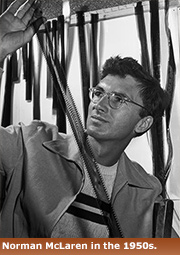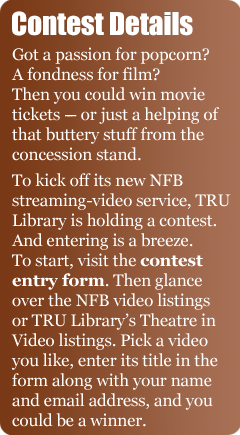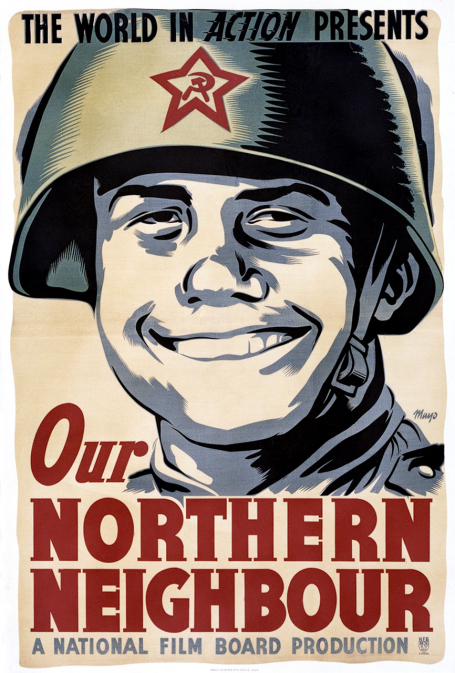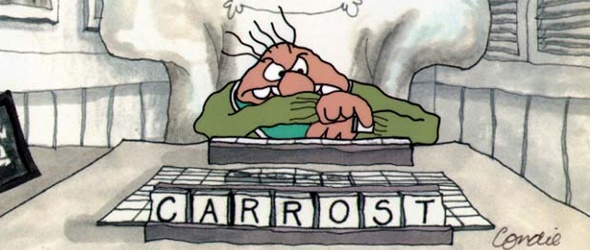Posted on: February 4, 2013

 Your nation’s heritage is now showing on a screen near you – the screen in front of you, in fact.
Your nation’s heritage is now showing on a screen near you – the screen in front of you, in fact.
Note: The contest has concluded.
TRU Library has launched a subscription to several decades’ worth of NFB films, including a number of Academy Award-winners. The 2,000-plus films are now ready for streaming on any computer. And to kick off this powerful new resource, the Library is hosting a contest, with cinema tickets and popcorn as prizes (contest concluded on 15 Feb.).
The National Film Board of Canada has a renowned history of producing films that provoke discussion and debate on subjects of interest to Canadians. Those films have probed and documented Canada’s culture and history since the 1930s.
The NFB now has thousands of them on its website. And TRU Library’s new subscription means they can be streamed to desktops, laptops – and classrooms.
 “These films support the curriculum,” says Collection Services Librarian Penny Haggarty. “They’re also high-quality and award-winning.”
“These films support the curriculum,” says Collection Services Librarian Penny Haggarty. “They’re also high-quality and award-winning.”
One example is Norman McLaren’s Neighbours (AA, Best Documentary, 1952), a live animation (using “pixelation”) in which suburban neighbours kill each other, and their families, in a dispute over a flower.
The NFB films’ records are now loaded into the Library’s catalogue, making the videos as searchable and findable as books – and even more accessible. For example, simply type “NFB” into the catalogue’s keyword search box, and in your results, each streaming video includes a clickable ![]() icon linking you to the actual film. It’s that easy. (If you’re off-campus, you’ll need to authenticate with your student or faculty number and Library PIN.
icon linking you to the actual film. It’s that easy. (If you’re off-campus, you’ll need to authenticate with your student or faculty number and Library PIN.
The NFB’s service boasts “lots of neat features,” Haggarty says. “But to take advantage of some them, you need to set up an account.” Once registered, you can create play lists as well as “chapters” – film clips useful for showing in class. (For more about those features, click here.) Another advantage: whereas DVDs and VHS tapes wear out, the streaming videos don’t, Haggarty says. They also don’t need to be booked in advance for classroom use.
Another powerful film is Kanehsatake: 270 Years of Resistance, a passionate, point-of-view documentary about the Oka Crisis of 1990, a tense standoff that began with the killing of a Quebec police officer. Other films about land issues include You Are on Indian Land (1969) and Cree Hunters of Mistassini (1974).
powerful film is Kanehsatake: 270 Years of Resistance, a passionate, point-of-view documentary about the Oka Crisis of 1990, a tense standoff that began with the killing of a Quebec police officer. Other films about land issues include You Are on Indian Land (1969) and Cree Hunters of Mistassini (1974).
The new NFB subscription complements TRU Library’s Theatre in Video subscription, which focuses on videos of (and about) theatre productions (essentially, a lot famous productions of famous plays by Shakespeare, Pinter, Chekhov, Sophocles, etc.).
Some other noteworthy films on the new NFB subscription service:
- Churchill’s Island (1941). The first NFB film to win an Academy Award, even though it was wartime propaganda.
- Our Northern Neighbour (1944). More wartime propaganda, this time concerning the Soviet Union. Proof that the enemy of our enemy is our friend.
- Tomorrow is Too Late (1974), a prescient documentary about the salmon fishery.
- Waiting for Fidel (1974), a vivid look at the island-nation while Joey Smallwood and others try to line up a visit with Castro.
 Augusta (1976), a short portrait of an 88-year-old non-status Shuswap woman who lived alone in a log cabin without running water or electricity.
Augusta (1976), a short portrait of an 88-year-old non-status Shuswap woman who lived alone in a log cabin without running water or electricity.- North China Factory (1980), depicting a factory community in China where over 6,000 workers process, spin and weave raw cotton into 90 million yards of high-quality cloth per year.
- If You Love This Planet (1982), a cold-war classic that intercuts Dr. Helen Caldicott’s scathing account of nuclear threat with clips from Ronald Reagan’s movie career.
- Final Offer (1985). Featuring Bob White and the historic 1984 contract negotiations between the UAW and General Motors, it also concerns the emergence of automation and how it begins to affect the lives of the working class.
- The Big Snit (1985, see image below), Richard Condie’s 10-minute Oscar-nominated animation about an older couple playing Scrabble (in 1994 it was voted #25 of the 50 Greatest Cartoons of all time by members of the animation field).
- Through a Blue Lens (1999), a hard-hitting look at drug addiction on Vancouver’s Downtown Eastside.


